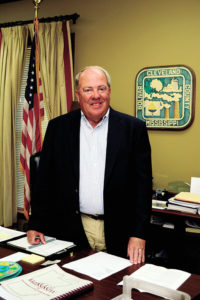By Becky Gillette
The population of the Mississippi Delta continues to decline, according to figures from the U.S. Census comparing populations in 2010 to 2018. Population losses in the largest cities in the Delta ranged from a decline of 14.8 percent in Clarksdale to 5.1 percent in Yazoo City.
 One major reason for the population loss in the Delta is an increase in ag and manufacturing technology that has led to fewer jobs, says Dr. Glendscene Williams, director, Center for Business and Entrepreneurial Research, Delta State University (DSU). Nevertheless, she says the standard of living of people currently living in these counties is improving and economic growth is occurring.
One major reason for the population loss in the Delta is an increase in ag and manufacturing technology that has led to fewer jobs, says Dr. Glendscene Williams, director, Center for Business and Entrepreneurial Research, Delta State University (DSU). Nevertheless, she says the standard of living of people currently living in these counties is improving and economic growth is occurring.
“So, what the counties need is a comparative advantage that requires lots of workers,” Williams says. “It’s impossible to know exactly what that will be, but it’s safe to assume that it will require workers who have a deep understanding of technology. The best strategy for today is to prepare the current and future work forces in those counties to work well with technology.
“Therefore, from an educational stance, we cannot miss out on the opportunities before us. We have the opportunity to create an entrepreneurial spirit in our Delta counties. We must invest more in innovation and technology training and research and development to support the demands of our new economy, and expose our youth at younger ages to the economics of how the world works.”
Chuck Espy says since he became mayor of Clarksdale two years ago, his administration has worked to be proactive by enhancing quality of life activities and working to cater to eighteen to thirty year-olds and give them opportunities that they have not had traditionally.
 “So far, we have been very successful,” Espy says. “We have invested time and effort into entrepreneurship for this age range of young adults, and we have entered into public-private partnerships to give more quality of life activities in our city. We are getting ready to break ground on a sports and convention center with an aquatic center, fitness center, and ballfields. We just did the groundbreaking for our Clarksdale Tourism Center\Wingstop franchise that will create twenty-five additional jobs.”
“So far, we have been very successful,” Espy says. “We have invested time and effort into entrepreneurship for this age range of young adults, and we have entered into public-private partnerships to give more quality of life activities in our city. We are getting ready to break ground on a sports and convention center with an aquatic center, fitness center, and ballfields. We just did the groundbreaking for our Clarksdale Tourism Center\Wingstop franchise that will create twenty-five additional jobs.”
Espy says more than 300 new jobs have been created in the city in the past two years. And the city is being very proactive in helping entrepreneurs open small businesses.
“So far we have seen a dramatic improvement in retaining population that has traditionally gravitated to others states,” Espy says.
Cleveland Mayor Billy Nowell was surprised at the decline in population, and says the 2020 Census will be more accurate showing what is going on with the city’s population.
 “A year or so ago, we heard some comparisons that Cleveland was the not only not losing population, but was gaining population,” Nowell says. “We have folks moving into Cleveland from smaller towns and rural areas in the Delta. We have more building permits issued now than in the history of Cleveland. There are new subdivisions and hotels being built in Cleveland.”
“A year or so ago, we heard some comparisons that Cleveland was the not only not losing population, but was gaining population,” Nowell says. “We have folks moving into Cleveland from smaller towns and rural areas in the Delta. We have more building permits issued now than in the history of Cleveland. There are new subdivisions and hotels being built in Cleveland.”
He sees the city’s strengths including a viable downtown that people enjoy visiting, the jobs and activities associated with DSU, and industries such as Baxter Healthcare that is currently doing an $80-million expansion expected to add sixty to seventy jobs. The school system and hospital are also big job and revenue creators.
Tom Gresham of Indianola, the new president of Delta Council, has a priority of addressing creative ways to combat depopulation.
“We’ve got to get more young people involved in shaping the future of the Delta,” Gresham says. “The Delta has so many things going for it and so many assets.”
 Gresham says more good jobs are key to stemming the population decline. That is why he is so excited about the Delta Strong project of the Delta Council that is working to make sure workers are trained and ready when needed by industry by providing training through the ACT Work Ready Communities program.
Gresham says more good jobs are key to stemming the population decline. That is why he is so excited about the Delta Strong project of the Delta Council that is working to make sure workers are trained and ready when needed by industry by providing training through the ACT Work Ready Communities program.
When a company expresses interest in locating or expanding in the Delta, they can be shown on a map how many Work Ready employees of various skill levels are certified in a thirty-mile radius.
“We have a great relationship with our community colleges and their training programs,” Gresham says. “They are working so well with our economic developers and Delta Strong to provide training needed for our existing workforce and new businesses that are moving in.”
Announcements of two major new industries locating in the Delta are expected soon.
“I really look forward to that,” Gresham says. “That is something that will continue.”
Total population projections for the future from the State Data Center of Mississippi predict continued variation in overall population numbers, even within the Delta region. Some counties will likely continue to have declining population numbers while others will increase.
 “When looking at county-level net-migration, it is important to consider that people can move between counties in the same region,” says John J. Green, Ph.D., director, Center for Population Studies at the School of Law, The University of Mississippi. “The sociological, economic, and community development literature strongly suggests that people make decisions on where to live for a wide range of reasons. Perceived quality of education, job opportunities, and amenities related to quality of life are of critical importance.”
“When looking at county-level net-migration, it is important to consider that people can move between counties in the same region,” says John J. Green, Ph.D., director, Center for Population Studies at the School of Law, The University of Mississippi. “The sociological, economic, and community development literature strongly suggests that people make decisions on where to live for a wide range of reasons. Perceived quality of education, job opportunities, and amenities related to quality of life are of critical importance.”
Green says there is a “spiraling dynamic” to the relationship between population and development. As people leave an area, for example, there is more pressure on services with a smaller economic base, thus driving more challenges.
“Although there is not a one-size-fits-all prescription for all communities dealing with population declines, it is important to attend to education, business retention and expansion, and both the physical and social infrastructure needed for people to have a high quality of life,” Green says. “Additionally, we should remember that places with increasing population sizes face their own challenges as well.”

